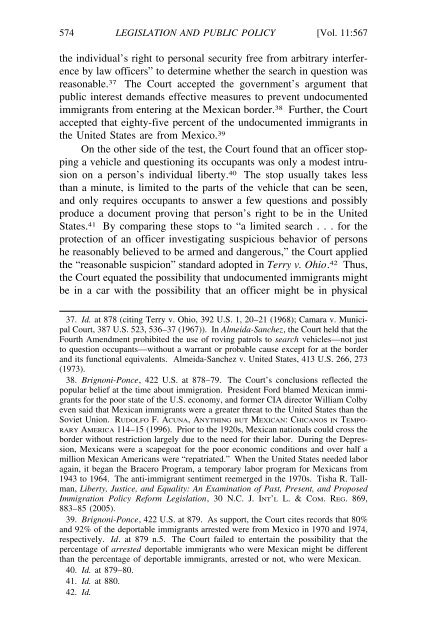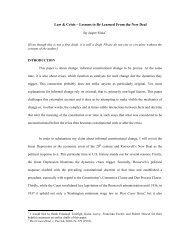updating brignoni-ponce - New York University School of Law
updating brignoni-ponce - New York University School of Law
updating brignoni-ponce - New York University School of Law
Create successful ePaper yourself
Turn your PDF publications into a flip-book with our unique Google optimized e-Paper software.
574 LEGISLATION AND PUBLIC POLICY [Vol. 11:567<br />
the individual’s right to personal security free from arbitrary interference<br />
by law <strong>of</strong>ficers” to determine whether the search in question was<br />
reasonable. 37 The Court accepted the government’s argument that<br />
public interest demands effective measures to prevent undocumented<br />
immigrants from entering at the Mexican border. 38 Further, the Court<br />
accepted that eighty-five percent <strong>of</strong> the undocumented immigrants in<br />
the United States are from Mexico. 39<br />
On the other side <strong>of</strong> the test, the Court found that an <strong>of</strong>ficer stopping<br />
a vehicle and questioning its occupants was only a modest intrusion<br />
on a person’s individual liberty. 40 The stop usually takes less<br />
than a minute, is limited to the parts <strong>of</strong> the vehicle that can be seen,<br />
and only requires occupants to answer a few questions and possibly<br />
produce a document proving that person’s right to be in the United<br />
States. 41 By comparing these stops to “a limited search . . . for the<br />
protection <strong>of</strong> an <strong>of</strong>ficer investigating suspicious behavior <strong>of</strong> persons<br />
he reasonably believed to be armed and dangerous,” the Court applied<br />
the “reasonable suspicion” standard adopted in Terry v. Ohio. 42 Thus,<br />
the Court equated the possibility that undocumented immigrants might<br />
be in a car with the possibility that an <strong>of</strong>ficer might be in physical<br />
37. Id. at 878 (citing Terry v. Ohio, 392 U.S. 1, 20–21 (1968); Camara v. Municipal<br />
Court, 387 U.S. 523, 536–37 (1967)). In Almeida-Sanchez, the Court held that the<br />
Fourth Amendment prohibited the use <strong>of</strong> roving patrols to search vehicles—not just<br />
to question occupants—without a warrant or probable cause except for at the border<br />
and its functional equivalents. Almeida-Sanchez v. United States, 413 U.S. 266, 273<br />
(1973).<br />
38. Brignoni-Ponce, 422 U.S. at 878–79. The Court’s conclusions reflected the<br />
popular belief at the time about immigration. President Ford blamed Mexican immigrants<br />
for the poor state <strong>of</strong> the U.S. economy, and former CIA director William Colby<br />
even said that Mexican immigrants were a greater threat to the United States than the<br />
Soviet Union. RUDOLFO F. ACUNA, ANYTHING BUT MEXICAN: CHICANOS IN TEMPO-<br />
RARY AMERICA 114–15 (1996). Prior to the 1920s, Mexican nationals could cross the<br />
border without restriction largely due to the need for their labor. During the Depression,<br />
Mexicans were a scapegoat for the poor economic conditions and over half a<br />
million Mexican Americans were “repatriated.” When the United States needed labor<br />
again, it began the Bracero Program, a temporary labor program for Mexicans from<br />
1943 to 1964. The anti-immigrant sentiment reemerged in the 1970s. Tisha R. Tallman,<br />
Liberty, Justice, and Equality: An Examination <strong>of</strong> Past, Present, and Proposed<br />
Immigration Policy Reform Legislation, 30 N.C. J. INT’L L. & COM. REG. 869,<br />
883–85 (2005).<br />
39. Brignoni-Ponce, 422 U.S. at 879. As support, the Court cites records that 80%<br />
and 92% <strong>of</strong> the deportable immigrants arrested were from Mexico in 1970 and 1974,<br />
respectively. Id. at 879 n.5. The Court failed to entertain the possibility that the<br />
percentage <strong>of</strong> arrested deportable immigrants who were Mexican might be different<br />
than the percentage <strong>of</strong> deportable immigrants, arrested or not, who were Mexican.<br />
40. Id. at 879–80.<br />
41. Id. at 880.<br />
42. Id.
















